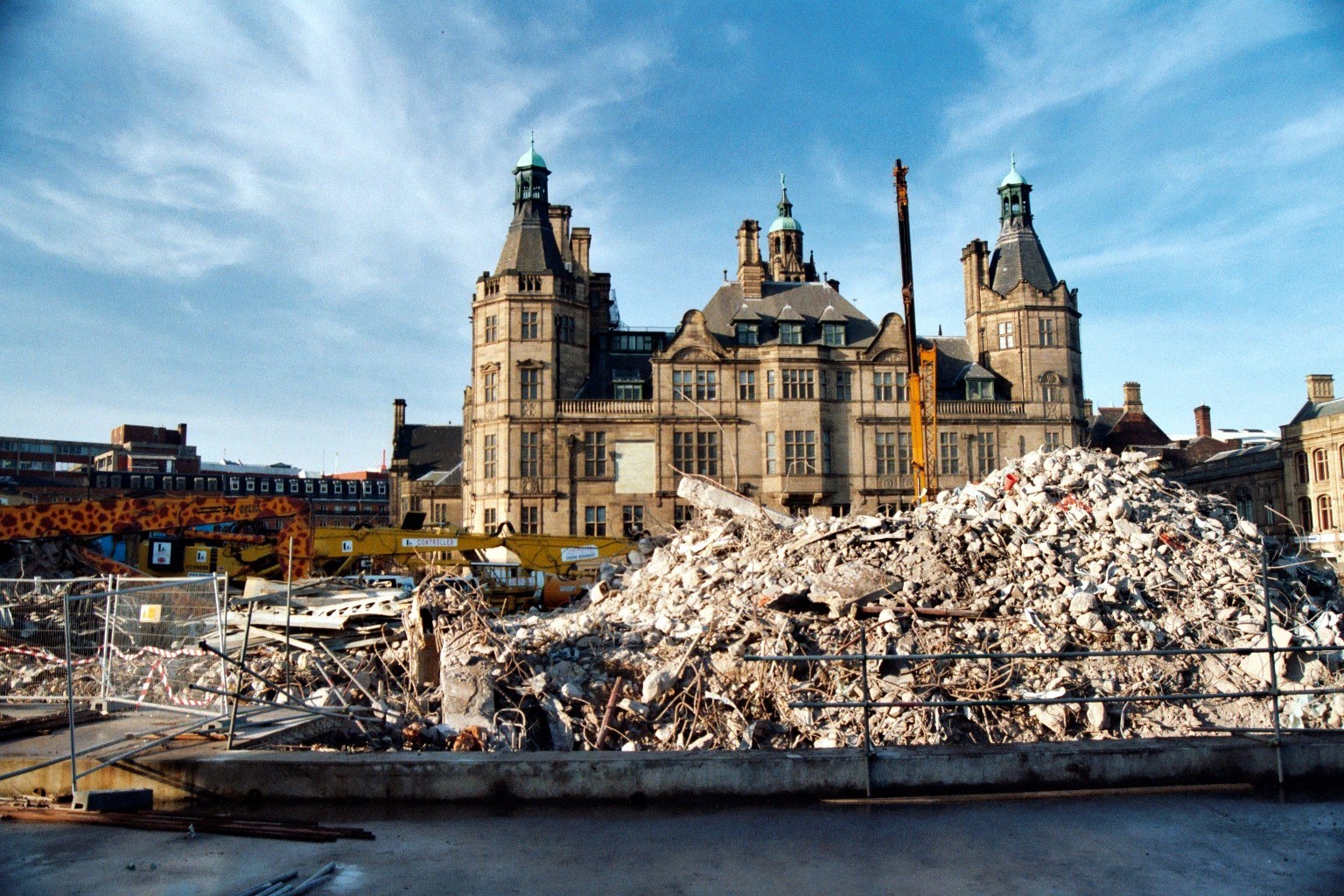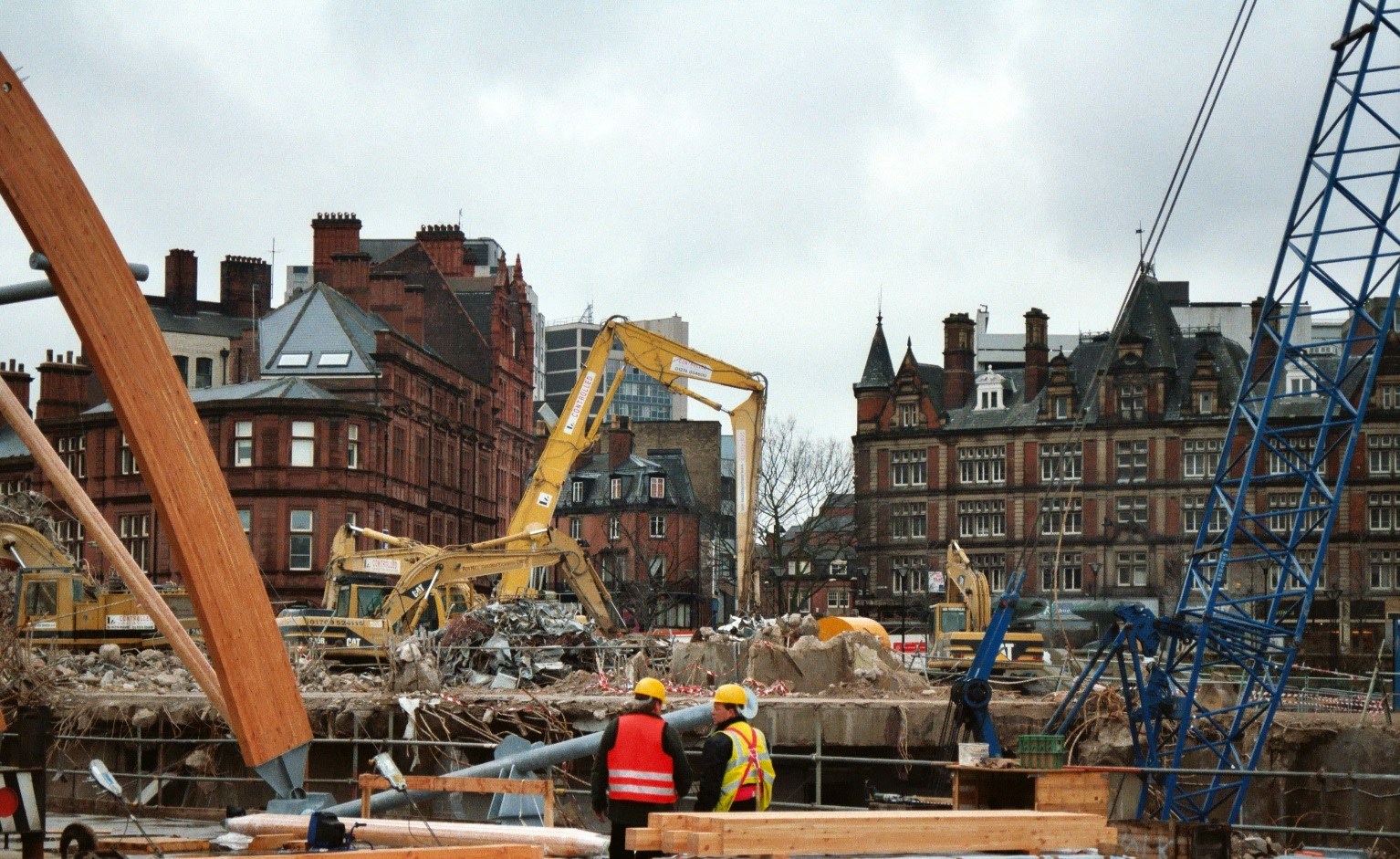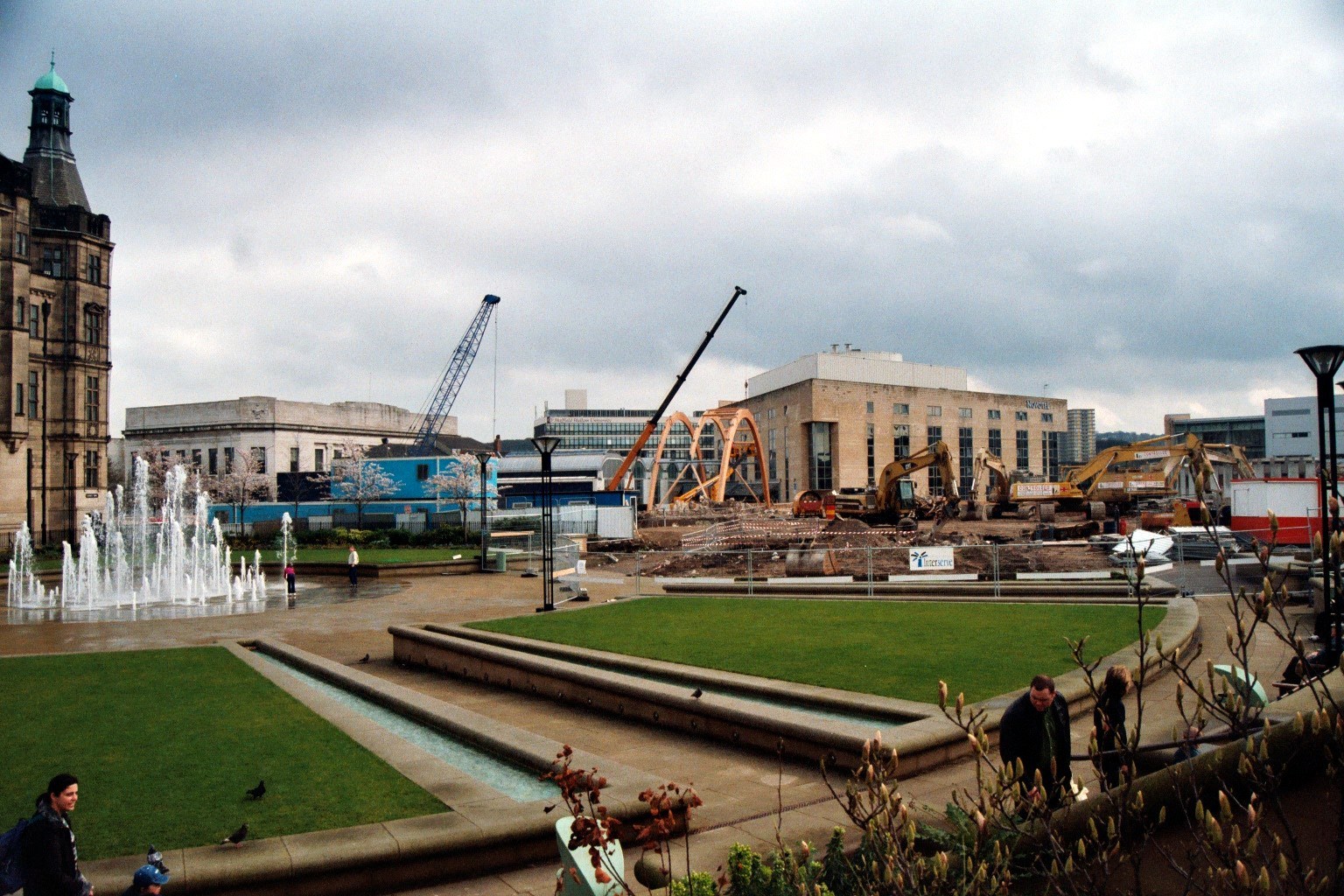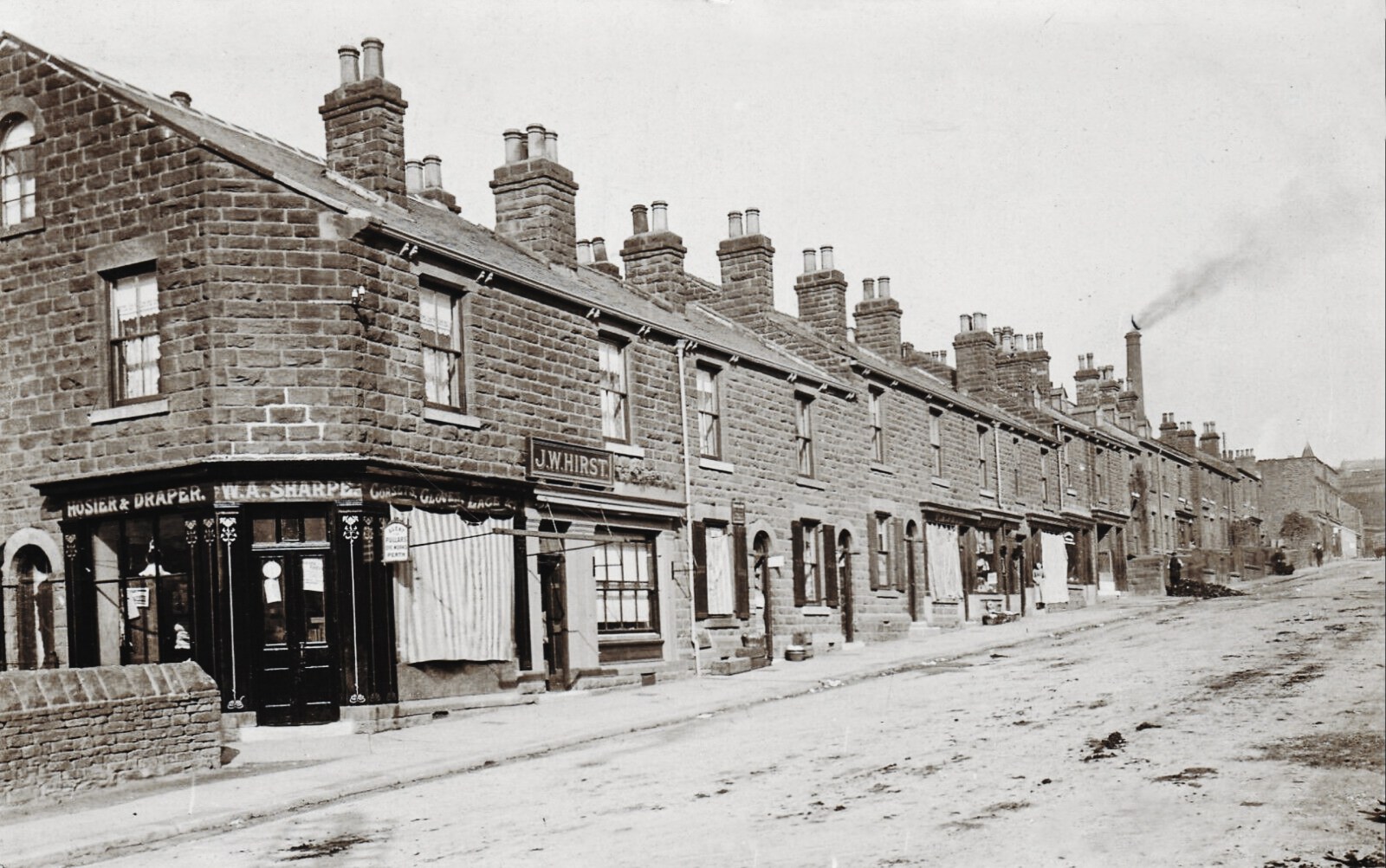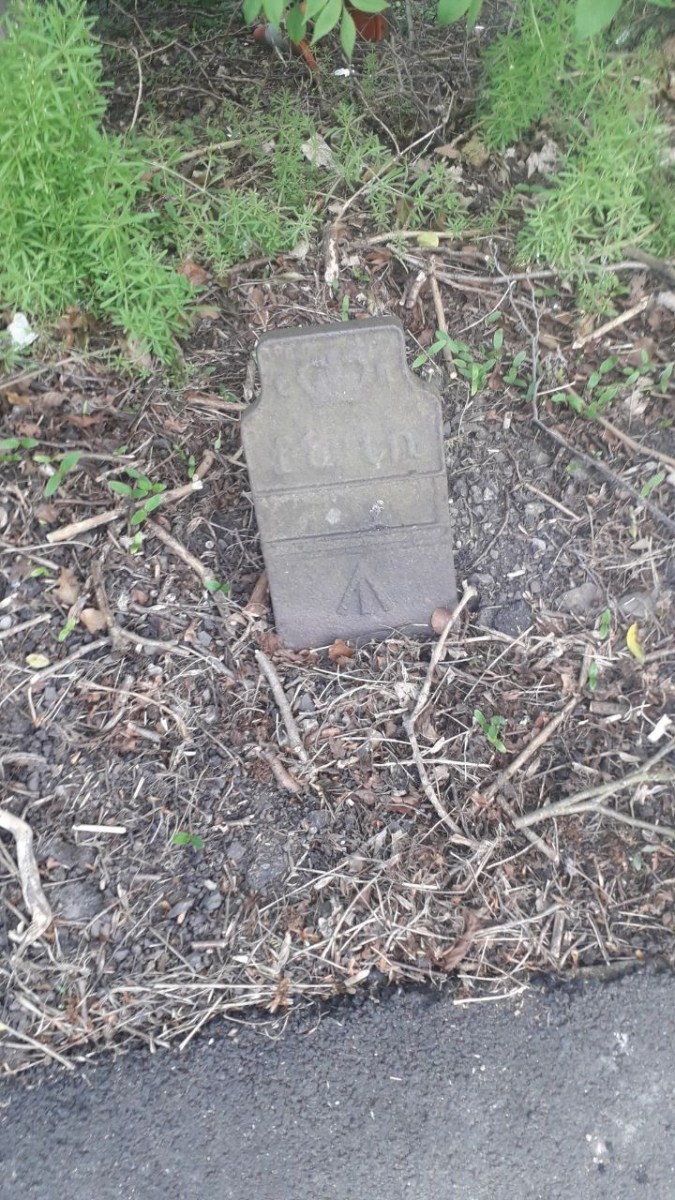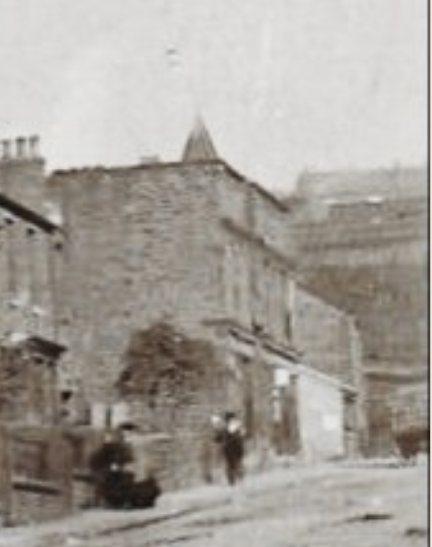Leaderboard
Popular Content
Showing content with the highest reputation on 03/05/20 in all areas
-
2 points
-
2 points
-
1 point
-
1 point
-
I can't find the picture I was thinking of but here is the best I can find at the moment. The chip shop is to the right and Beres Pork shop replaces the drapers. I am sure many will remember their pork sandwiches, I think they had a few shops or perhaps still have? EDIT - I see that they are still in business and in a big way. My mouth is watering just thinking of those sandwiches. http://www.beresporkshop.co.uk/about.asp https://picturesheffield.com/frontend.php?keywords=Ref_No_increment;EQUALS;s26405&pos=223&action=zoom&id=288301 point
-
Hi Athy. The only John (Jack) Warhirst I remember lived in those houses on Gleadless Road almost opposite the church. He was a keen Star Waker and ended up a champion. Jack would be about 73-75yrs if he's still alive. I can't remember how tall he was but he's referred too quiet a bit in Sheffield Histories and there's also a photo. Cheers, Wazzie Worrall1 point
-
Hi Bob, It was great to hear from Mick Hartley, now living in Skegness! Once this nonsense is over we'll try and arrange a meet. Keep smiling and in touch. Cheers, Wazzie.1 point
-
My good friend Richard Stacey was with me on this one and I think the tickets were courtesy of a rep who came to the mighty Record Collector. Awesome1 point
-
Is that kid on the left gurning on purpose or is he two sandwiches short of a picnic? I also note that the plump boy at back right is still in short trousers but has an oddly middle-aged face! I've mentioned Gleadless Country in other threads, but for new readers:I'm Michael Atherton, attended the school from 1954 to 1960, lived at 13, Gleadless Avenue. Two doors up from us were the Webs, whose daughter Carol was about 2 years ahead of me. Across the road were the Ledgers: I think both their boys, Philip and David, had been at the school, but they were several years older than me.1 point
-
This article first appeared in the Transactions of the Hunter Archaeological Society, and is reproduced by kind permission of the Society. JOHN CURR AND THE DEVELOPMENT OF THE SHEFFIELD COLLIERIES, 1781-1805 By IAN R. MEDLICOTT I When the Duke of Norfolk's Sheffield collieries were taken into direct management in 1781, the trustees of the estate were faced with a financially bankrupt and technologically backward concern. Over the next 20 years these collieries were transformed into the largest and most technologically advanced in South Yorkshire. How did the change come about? Why did the 11th Duke of Norfolk revert to the role of colliery lessor? The Sheffield estate of the Dukes of Norfolk lay on the Yorkshire, Derbyshire and Nottinghamshire coalfield, on the rich outcrops of the Barnsley, Parkgate and Silkstone seams. These were the richest coal seams in South Yorkshire, covering the whole range of steam, manufacturing, house, gas and coking coals. The consolidated nature of the Norfolk estate allowed the coal to be mined without expenditure on way-leaves or freeholders' minerals. The most important factor which enabled Norfolk coal to be worked on an extensive scale was the industrial expansion of Sheffield from the seventeenth century onwards, in the production of iron and steel, cutlery, scythes, files and saws. In the eighteenth century, the adoption of coke in the production of iron and steel, Huntsman's crucible steel-making process and Cort's reverberatory furnace further stimulated the demand for coal. The industrial expansion of Sheffield, coupled with the increase in consumer demand following a rise in population, created a large local market for coal. Coal had been worked on the Sheffield estate in Handsworth, Gleadless, Dronfield and Sheffield Park during the sixteenth century. Stone gives some indication of the extent of the Sheffield Park Colliery between July 1579 and December 1582. Output varied between 1,304½ loads (1,174 tons) and 1,515 loads (1,363 tons) per annum, or approximately one-fifteenth the size of a large-scale mine. Frequent official holidays reduced the possible working days to 280 per annum, and with absenteeism the pits lay unworked for a large part of the year. Wages were probably supplemented by labouring or the cultivation of small-holdings.[1] The seventeenth century witnessed the more extensive working of coal in the Sheffield area, following an expansion of the cutlery and fine-edged tool industry. For example, in 1635 Thomas Howard, Earl of Arundel, leased the Handsworth Park Pits for 40 years at £60 per annum, which by 1656 produced 1,600 loads (1,440 tons) of coal. An entry in the estate accounts for 1636 refers to a new coal mine on the `Parke ' Hill toppe'; whilst to the north of Sheffield pits were being worked at Mortomley and Chapeltown in 1637.[2] An even greater expansion in the exploitation of coal occurred during the eighteenth century, and especially after 1750, with the widespread adoption of coke in the iron and steel industry. Collieries became more extensive and the ensuing demand for coal enabled mineral owners to enforce higher rentals. In 1737, for example; John Bowden of Beighton leased the Duke of Norfolk's pits in the Park and on Attercliffe and Darnall Commons for an annual fixed rent of £400 plus one-fifth of the value of all coal worked in excess of this sum.[ 3] On expiry of Bowden's lease in 1758, the Wood Pits and Manor Colliery were taken under direct estate management. The reasons for this are not clear. Norfolk may have encountered some difficulty in finding a lessee, due to the depressed state of the coal market and the near exhaustion of the pits. The mines could not have been abandoned without adversely affecting those manufacturers who relied on coal supplied by the pits and who would have been in danger of not being able to pay their rents to Norfolk. The industrial rents comprised a large part of total estate revenue; out of a total annual revenue of £13,206-5-7½ in 1761-2, the income from forges and furnaces amounted to £3,851-9-0½ with the Sheffield Park and Manor collieries contributing a further £1,150-0-0. Thus Norfolk and his industrial tenants would have been seriously affected by a closure of the pits. Accordingly, the Sheffield pits were purchased from Bowden for £194-16-9½ in 1758 and Norfolk began paying himself a rental of £1,000 per annum from the balances. Old pits were filled and new ones opened, and as a consequence output at the Manor Colliery rose from 20,402 corves (797 tons) in 1758-9 to 37,554 corves (1,467 tons) in 1761. Even the Wood Pits were able to increase production from 140,655 corves (5,494 tons) in 1761 to 156,000 corves (6,094 tons) in 1762, in spite of severe competition from a colliery on Attercliffe Common.[4]. The Sheffield collieries were able to take advantage of the increased demand for coal after 1760. Even so, Norfolk was a reluctant colliery proprietor for when suitable lessees were found in Townsend and Furniss, the collieries were again leased in 1765. The fixed rent of £1,000 per annum provided Norfolk with an income similar to when his collieries were under direct estate control, but without the risks of direct management.[5] Although Norfolk had leased the mines, viewers had to be employed to report on the condition of the collieries and recommend improvements, for any mismanagement could lead to a loss of revenue in later years. For example, a report on the Sheffield Park Colliery in 1773 suggested a more efficient mode of working the mine. This entailed working four pits instead of five and the installation of gins to draw the larger 16 peck corves (1.25 cwt) to replace those of 10 pecks (0.78 cwt). A more significant recommendation was for a waggon-way to be constructed into the town to reduce transport costs from 2s 6d to 1 s 0d per load (42.5 cwt), and enable Norfolk to raise the colliery rental .[6] The waggon-way, made of oak and beech rails ran for 1 3/4 miles, and was completed at a cost of £3,280 in 1774. Norfolk raised the colliery rental, until by 1779 the lessees were paying £460 more than their old rent. In spite of the waggon-way, the increased rental and loan payments proved too burdensome for the lessees and contributed towards a financial crisis and their eventual withdrawal from mining. The serious financial difficulties encountered by the lessees in the late 1770s prompted a series of reports on the state of the collieries and it was at this time that John Curr was employed as a colliery viewer. John Curr (1756-1823) was born in County Durham where he received his training before being employed as viewer to the Duke of Norfolk mines in Sheffield. Why Curr was appointed is not clear, but two of the trustees placed in control of the Sheffield estate on the death of the 9th Duke in 1777 were the Earls of Scarborough and Strafford who had mining interests in the Great Northern Coalfield and who may have heard of his abilities. The trustees would have called for a report on the state of the collieries on taking control in 1777, whilst the condition of the mines necessitated a closer supervision.[7] The reports submitted by John Curr and John Stephenson of Kimberworth Park Colliery, Rotherham, state clearly the.,reasons for the financial crisis facing the Sheffield collieries. Profits were insufficient in relation to the capital invested and the costs of production had increased as the workings moved further from the town and deeper under the Park, where geological faults became more prevalent. The cost of leading coal into the town had increased. Revenue was also affected by an increase in the proportion of low value small coal extracted in relation to hard coal. In 1774 the ratio of hard coal to small was three to five; a proportion which had declined to one in three by 1779. It is not surprising that the downward trend in profits continued until by Christmas 1778 the collieries were £60 in deficit, with a forecast that by 1779 this would amount to £250. The Gleadless Colliery was also being worked at a loss of £100 per annum by 1781; and a report, suggested that the rent should be held back for 3 years. [8] II The lessees felt unable to continue with the collieries, and on Lady Day 1781, they surrendered their lease. As new lessees would not have been attracted to such an unprofitable enterprise, which required considerable capital investment to overcome the severe geological difficulties, as well as competition and a slump in the coal market, the Norfolk estate was obliged once again to take over direct control of the collieries. The decision to bring the collieries under direct estate management marked a crucial point in their development, for the Sheffield estate was probably the only concern that was prepared or capable of investing the necessary capital in such a high risk venture. The future development of the collieries came to rest on Norfolk capital and, the mining expertise of John Curr. Considerable capital was expended on the modernisation and extension of the Sheffield Park and Manor Collieries and in sinking new mines. For example, by 1784 some £4,700 had been invested in the Wood Pits and between 1786 and 1790 £13,823 had been spent on the new Attercliffe Colliery.[9] The degree of executive authority exercised by Curr over the collieries is difficult to assess. What evidence there is suggests that Curr had considerable freedom in the management of the mines, but he was accountable to Vincent Eyre, the land agent, to the trustees and later to the l l th Duke of Norfolk; Curr's accounts were audited by Henry Howard until his death in 1787. In addition, reports on the collieries were submitted by John Stephenson and John Buddle senior, one of the foremost mining consultants of the period. As Superintendent of the coalworks of his Grace Duke of Norfolk, Curr's responsibilities covered such diverse areas as ventilation, drainage, haulage, pit sinking, opening new collieries, sales, employment, supervision of workers and keeping the accounts.[10] Curr was also expected to solve any technical problems and to introduce the necessary innovations to facilitate the efficient extraction and movement of the coal. Not only was he responsible for the overall management of the collieries but he bore the further burden of profit creation and supervision of the capital investment programme. Such a varied area of responsibility made it virtually impossible to have detailed control and expertise over all aspects of management. It is in the area of mine engineering that Curr is better known, with several of his innovations being adopted in many coalfields. A major advance was made in the technology of pit haulage and winding, which enabled larger quantities of coal to be moved more quickly from the work places to the surface. Curr replaced the hazel wickerwork kibbles that held 14 cwt of coal with the larger, four-wheeled corf constructed of solid wooden planks attached to an iron frame and capable of carrying 5½-6 cwt of coal. The novelty of Curr's design was that the whole corf and tram could be raised up the shaft, thus replacing the usual practice of reloading at the pit bottom. Waggon-ways were constructed underground at the Sheffield Park Colliery in 1783, and the first payments for the boys who led the horse-drawn corves were recorded in the accounts in January 1784. The rails were made of beech and it was not until shortly before April 1787 that the colliery account books recorded payments for cast iron plates. Although Curr's waggon-ways marked a cul-de-sac in later rail development, as the flange was on the rail, they did solve the immediate problem of moving large quantities of coal from the work places. Hatchett, who was on a tour of the manufacturing districts of England and Scotland in 1796, wrote that a single horse could pull 12 to 14 fully loaded corves at a time, whilst Curr claimed that where the ground fell ½ inch in the yard, up to 24 corves could be hauled. This compares with an average of 2 or 3 that could be hauled at any one time in the Newcastle area.[11] To overcome the damage caused by corves colliding with each other and with the pit shaft, a system of conductors was devised whereby the corves were suspended below a crossbar which ran with the aid of rollers within two pairs of deal rails that formed guide rods. This system not only reduced the risk of collision in the shaft but allowed the corves to be raised at a much greater speed, with two corves being lifted out of the mine at the rate of 840 feet per minute. Curr invented a system of emptying the corves by tiplers; whereby two empty corves were pushed forward ready to go down the shaft, while at the same time the full corves were moved towards the tipler for mechanical unloading. On examination of Curr's new method of hurrying, Buddle reported that it was... ‘founded on true mechanical Principles'; and would save 34d per waggon or £321-10-0 per annum. [12] Major advances were also made in rope technology; for as the collieries increased in depth stresses on the rope became more severe. Curr invented the double rope which could draw more than twice the weight of the usual rope. In 1798 the flat rope was introduced to overcome the unequal stresses on the winding axle as the full corves were being wound from the pit bottom while the opposing empty corves were at the top. This invention comprised several circular ropes stitched together, and it was claimed that it could do six or seven times as much work as the `Common Ropes'.[13] Other innovations devised by Curr included improvements to his original corf design by the insertion of a brass bush into the corf wheel, through which ran the axle. When the bush was worn, it was replaced instead of the whole wheel being discarded. On the surface, waggon-ways and inclined planes were installed to move the coal either to the coal stack or directly into the town. Curr found that the efficiency of pumping engines could be achieved by raising the cistern 36 inches above the cylinder top, instead of the usual 12-14 inches. This produced a better vacuum and provided more power without the use of additional fuel. The last 20 years of the eighteenth century saw the Norfolk collieries in the forefront of mine haulage and winding technology, and the adoption of many of these improvements in other coalfields enabled Curr to claim that he had received ` . .. something handsome for the Patent Rights from sundry Proprietors of Collieries'.[14] To take advantage of the demand for steam pumping and winding engines, Curr established an iron foundry in 1792 to supply iron castings, rails, engines and cylinders ranging from 14 to 32 inches. The bulk of the iron purchases for the Norfolk collieries was made from the foundry, and between 1792 and 1801 it supplied goods to the value of £14,069-0-0. Although this situation was open to abuse it did allow Curr a valuable facility to construct and devise improvements for the collieries. The increased expenditure by collieries on iron goods illustrates the interrelationship in the development of the coal and iron industries during the late eighteenth century. Whereas before 1765 the major items of expenditure in the Sheffield collieries included pit sinking, headings, punches and driving soughs, by 1781 iron goods became the largest single item of purchase. Out of a total expenditure of £13,822-16-11 in opening the Attercliffe Colliery, £3,450-15-1½ was for iron goods. This was an on-going process with the collieries submitting regular orders for steam pumping and winding engines, waggons and rails, whilst the ironworks in turn demanded regular supplies of coal.[15] As remuneration for his position as `Superintendent', Curr's salary was based on a fixed rate per colliery that did not vary in spite of inflation during the last 20 years of' the eighteenth century. His annual salary included £100 for the Sheffield and Manor Colliery, £70 for the Attercliffe Colliery and £20 for the Hesley Colliery, with an additional £25 for viewing and measuring the coal and ironstone mines under lease. Certainly Curr did not look upon his salary as generous in relation to the responsibilities that went with the position, and for the expenses he had to pay. These expenses included the salary for an assistant clerk, hay, keep of a horse, house tax, coals, candles for an office and an agent's house, which he claimed were generally paid for by other proprietors. [16] On inheriting the Sheffield estate in 1786, the I1th Duke was unwilling to bear the full financial burden in the exploitation of the estate's minerals. Norfolk took as an equal partner his land agent Vincent Eyre, who had already invested `many thousand pounds' in the Attercliffe Colliery. Capital costs and profits were to be shared equally between the partners. Even so, Norfolk was not following the general trend of landowners at this time who had divested their mining interests, although supervision of the enterprise could be left more in the hands of Eyre, who, due to a large financial stake in the enterprise, had an additional stimulus to see they were correctly managed.[17] The major capital investment prior to 1801 was in the sinking of the Attercliffe Colliery that was opened to work 90 acres of coal at a depth of 100 yards. Sinking commenced in December 1786 with production starting two years later. Expenditure on the colliery between December 1786 and June 1790 was approximately £13,822-16-11. Another colliery was sunk at the Ponds in 1789 and whilst no evidence as to cost has been found, Buddle produced an estimate for a colliery on the site of £4,500 in 1787. Although the demand for coal had declined by 1800, existing collieries had still to be extended and new coal broken into. This was the case with the Sheffield Park Colliery, but instead of extending the workings further under the Park at depths greater than 100 yards, the decision was taken to open a new, but shallower colliery at Crooks Croft in 1803-4. This was to become the major coal producing unit in Sheffield. A lack of documentary evidence prevents an accurate calculation of the total capital investment made in the exploitation of the coal reserves between 1781 and 1805, but Curr stated that by 1793, some £20,000 had been expended on the Sheffield collieries.[18] The extension and opening of new collieries were not the only areas of major capital expenditure, for when the opportunity arose, neighbouring mines had to be purchased to prevent them falling into the control of competitors, to consolidate the Norfolk monopoly and to extend the coal reserves. With these factors in mind the Darnall Colliery was acquired in 1798 for £8,500 from Clay & Co., and the Dore House Colliery for £5,313-10-0 in 1801.[19] The extensive programme of capital expenditure, coupled with Curr's technological improvements, were not reflected in any dramatic increase in output at the Sheffield Park and Manor Collieries. The estimated maximum annual production at the Wood Pits (Sheffield Park Colliery), was 19,800 tons in 1773 compared with an average annual output of 18,227 tons per annum between 1781 and 1801. An overall increase in coal production was achieved only by opening new collieries at Attercliffe, the Ponds and Crooks Croft. Whereas the Sheffield Park Colliery produced 23,351 tons in 1800-1, the output of the new Attercliffe Colliery amounted to 44,538 tons out of a total production for all the Norfolk collieries of 99,840.[20] The Sheffield collieries provide an example of how a large local industrial and domestic market could stimulate mining on a large scale. Initially the coal market depended mainly on the cutlery and fine-edged tool manufacturers, but towards the end of the eighteenth century, the expansion of the iron and steel industry made an increasing impact. The numerous wars in the eighteenth century resulted in short-term booms in the heavy industrial sector, especially when manufacturers were recipients of government munition contracts. For example, three-fifths of the total output of 1,221 tons of iron cast at the Walker's Masborough ironworks in 1781 went to the government. On the other hand wars, especially the War of American Independence, dislocated foreign trade and adversely affected the cutlery and fine-edged tool manufacturers. Upon the termination of hostilities in North America, Booth & Co. erected an iron furnace in Sheffield Park, and output at the Sheffield Park Colliery rose from 10,693 waggons (16,039 tons) in 1783-4 to 14,344 waggons (20,682 tons) in 1784-5. The ensuing boom in coal demand led to an acute shortage in supply and encouraged Norfolk to open the Attercliffe Colliery in 1786.[21] The declaration of war against France in 1793 again disrupted the overseas markets of the Sheffield manufacturers, and even by 1796, trade had not recovered. Output at the Sheffield Park and Attercliffe Collieries declined from 62,527 tons in 1791-2 to 43,609 tons in 1794-5. But as the French Revolutionary and Napoleonic Wars progressed, the shortage of iron and opportunities for large profits led to an expansion of heavy industry through munition contracts and orders for colliery equipment. Even the cutlery trade, with new markets in North and South America and extensive smuggling into Europe to circumvent Napoleon's continental system, was able for a time, to recover and flourish. The Sheffield manufacturers were able to adjust to war-time conditions and by 1800-1 the Sheffield Park and Attercliffe collieries raised output to a record 67,889 tons.[22] However, this boom was short-lived, with trade again being severely hit by the American trade embargo of December 1807 and a tightening of the Napoleonic blockade in 1810. The Dukes of Norfolk had a monopoly of the Sheffield coal market and it was therefore in their interest to protect this from outside competition. In 1751, for example, the Don Navigation was terminated at Tinsley, some 3 miles from the town centre, following obstruction from the Norfolk estate. A turnpike road was allowed through the Park only on the understanding that Norfolk coal should be excused the payment of tolls within the Park. Booth & Co. of the Park Ironworks were granted a lease in 1784 to mine coal and iron but were defeated by water in their attempt to sink a pit after spending upwards of £3,000, and even a second attempt proved disappointing. The lessees tried to sell their excess of small coal but were accused of selling in direct competition to the Manor Colliery and so were ordered to close the mine without compensation. Thereafter Booth & Co. were obliged to buy directly from the Norfolk collieries where the price of hard coal rose from 5s in 1796 to 9s per ton in 1804. The Norfolk coal monopoly was also reinforced when leases were granted to industrial tenants. For example, in their original lease of 1763 Booth & Co. were obliged to purchase coal from a Norfolk colliery if there was one nearby, whilst Swallow, who leased a colliery in Hesley Wood, Chapeltown, could mine coal only for his ironworks, except for £60 of `slack' coal which he was allowed to sell to local smithies.[23] Not only did the Norfolk coal monopoly enable the collieries to raise prices higher than under conditions of competition, but the relatively small number of collieries in Sheffield and their inelasticity of supply created a shortage of coal during , periods of high demand. During the local iron industry boom of 1792 the shortage of coal was so acute that it prevented the `regular' working of several steel furnaces and manufactories. Coal prices were raised, with the `Dross' coal from the Sheffield Park Colliery being increased from 15s to 17s 6d per waggon (30 cwt), and the small from l0s to 11 s 8d per waggon in 1792. The shortage of coal and rising prices encouraged a group of Sheffield businessmen, including seven steel makers, four merchants, two iron-founders and two refiners, to sink their own colliery at Dore House. Although this colliery was initially profitable, it was unable to survive the slump after 1794, and the owners were eventually forced to sell out to Norfolk and Eyre in 1801. But whilst the Dore House Colliery was unable to break the Norfolk monopoly, they were successful, for a while, in holding steady the price of coal in Sheffield.[24] The greatest extent of the Norfolk coal monopoly was achieved in 1801 on the purchase of the Dore House Colliery. The Norfolk pits accounted for 101,400 tons or 81.12 per cent of the 125,000 tons of coal consumed by the Sheffield manufacturers from 16 collieries in 1803.[25] This dominance of the Sheffield market was to last until the opening of the Tinsley Canal in 1819, and was not finally broken until the Sheffield to Rotherham Railway was constructed in 1838. III To what extent was the capital expenditure on the collieries between 1781 and 1801 reflected in increased profits? Soon-after the collieries were taken under direct estate control, profits showed a marked improvement as a result of capital investment, Curr's technical innovations and an upturn in the demand for coal. In 1781-2. the Sheffield Park and Manor Collieries returned a profit of £1,823-15-2, which had increased to £3,773-15-8 in 1791-2, whilst the total profit of the Sheffield Park, Manor and Attercliffe collieries amounted to £5,411-18-4. From this peak the profits steadily declined until by 1797-8 total profits of the collieries were only £1,747-4-8½ with losses recorded at the Attercliffe Colliery in 1796-7 and the Sheffield Park and Manor collieries in 1800-1. Apart from 1791-2, profits from the collieries also remained a small percentage of total estate revenue, varying from 6.75 per cent in 1781-2 and 14.65 per cent in 1791-2 to 3.91 per cent in 1797-8, with the colliery profits not keeping pace with the increase in agricultural rents for the period 1781-1801[26] What were the reasons for such a dramatic decline in the profitability of the collieries? Whilst the introduction of Curr's innovations made the Norfolk collieries some of the most technically advanced in the country and almost certainly enabled some savings in production costs, these were negated by a fall in demand for coal, severe competition and a rapid rise in wage and material costs between 1794 and 1800. The last 20 years of the eighteenth century was a period of general inflation which affected the whole range of production costs, from wages to animal feedstuffs. Inflation was further aggravated between 1790 and 1800 during the French Revolutionary and Napoleonic Wars, when production costs more than outweighed the increase in output and coal prices. [27] In 1801, Curr commented on the difficulties facing the nation's collieries and in particular the lack of profits from the Norfolk mines and a neighbouring pit owned by Staniforth. `The high prices of hay and Corn, Workmens wages in acct. of the high price of Provisions, Punch Wood and leading, Deal Timber, Powder, Ropes, Candles, Iron, Cast Iron, & Oyl (sic) & have for 2 years past been distressing.. '[28] The state of the Norfolk collieries was exacerbated by an increase in competition from two collieries sunk in the 1790's at Dore House and Intake, in addition to those at Darnall and Attercliffe, which prevented an increase in coal prices to compensate for the rise in the costs of production. Referring to the Dore House Colliery, Curr remarked that: `The loss to themselves in Interests and money sunk has been about £8,000, but the loss sustained (in being deprived of their consumption, and keeping down the price of Coals) has been 3 times as much to the Duke's Collieries.'[29] Profits were also affected by internal cost factors such as geological faulting, deeper workings, drainage problems and the increased distance from markets. For example, Staniforth was accused of breaching the barrier that separated his mine from the Darnall and Attercliffe collieries, and which allowed a vast amount of -water to enter the workings. At least four pumping engines had to be installed at the Attercliffe Colliery whose running costs amounted to £3,000 per annum, and whose total sales in 1799-1800 were only £9,335-0-0. The cost of working the pumps is reflected in the amount of coal consumed by the engines and fire pan, an item that rose from 5,585 tons in 1789-90 to 8,435 tons in 1799-1800. Norfolk and the executors of Vincent Eyre took Staniforth to the York Assizes in 1803, claiming damages of £10,000 for lost production, but they were not successful in their prosecution .[30] The increase in production costs can be seen in the average cost per ton. The estimated average wage cost in the production of 19,800 tons of coal at the Wood Pits (Sheffield Park Colliery) was 1s 4½d per ton in 1773; this had risen to 1s 10¾d per ton on 22,203 tons in 1790-1 and to 3s 2d per ton on 16,426 tons by 1797-8. Wage costs are not available for the Attercliffe Colliery, but average total working costs rose from 2s 3½d per ton in 1790-1 to 4s 0d per ton in 1797-8, and while these costs rose by 57.5 per cent in seven years, output declined by 5,517 tons, from 36,456 tons to 30;939 tons. [31] The adverse effects of inflation and production difficulties would probably have been even more severe without the high level of capital investment and Curr's costsaving innovations. Curr claimed that: `... bad as the Collieries have lately proved, they would have been much worse if I had not made the improvements I have stated...'. Even so, it was the continued unprofitability of the collieries that persuaded Norfolk to dismiss Curr on 14 October 1801 after more than 20 years' service: ‘. . . the want of success in concerns so important to myself & the trade of Sheffield, has appeared to me a sufficient reason for placing the management of them in other hands, to try whether different measures may produce better consequences.[32]' If the collieries had been owned by a proprietor in closer touch with his management, the dismissal of Curr could well have occurred sooner. There does appear to be some doubt about the ability of the Norfolks to respond quickly to changing managerial and market conditions, as shown by the late attempt to remedy the financial deterioration of the collieries. On the other hand, estate and personal interests made it difficult for the landowner to exercise detailed control over all estate activities, and Mee's description of the Earls Fitzwilliam could be applied equally to the Dukes of Norfolk: ‘. . . the Earls Fitzwilliam inevitably had to leave matters of day to day administration in the hands of their local managers ... therefore, for much of the time they were attempting to control the collieries and other enterprises from a distance and consequently had to rely mainly on the correspondence and the regular submission of accounts and reports from the manager, to maintain contact. ..'[33] However, Curr's dismissal came at a time when output, sales and profits were already improving. Strict economics and an increase in coal prices meant that profits continued after 1801. The number of pumping engines at the Attercliffe Colliery was reduced from four to two, and price increases followed a reinforcement of the Norfolk monopoly upon the purchase of the Dore House Colliery in 1841. These actions enabled Norfolk and the executors of Vincent Eyre to withdraw £21,000 between 1804 and 1805.[34] Whilst Curr was a highly proficient mining engineer, there are some doubts on his ability as a manager. During a period of rapidly falling profits and rising production costs, he probably kept an insufficient check on capital investment in relation to its financial return, without the necessary emphasis on raising output and lowering unit costs. Some indication of this can be seen between 1801 and 1805, when profits rose after a reduction in capital equipment and an increase in coal prices. Likewise, the lessees who took over the collieries in 1805 were able to raise output and profits. For example, the Sheffield Park Colliery's output of 22,351 tons in 1800-1 was increased to 64,848 tons in 1817. This increase in output was achieved in spite of a dramatic reduction in plant and machinery from £12,656-5-9 in 1805 to £7,748-18-4½ in 1820. However, the lessees do appear to have gone to the opposite extreme in order to achieve profit maximisation, to the detriment of Norfolk's long-term mining interest. Collieries were run down, fixed stock depleted and the easier coal worked, so that by 1820 a total of £18,000 was required to be spent on the collieries.[35] Another factor that may have contributed to managerial inefficiency and a reduction in the cost effectiveness of the collieries was the lack of delegation of executive responsibilities. Although this situation reduced the chance of embezzlement or fraud, it required a `superintendent' like Curr to have expertise in all aspects of management from mine engineer and sales director to cost accountant. Even so, it must be remembered that colliery entrepreneurs at this time were pioneers in modern management practices. IV In spite of the increase in profits between 1801 and 1805 it appears that Norfolk was waiting for an opportunity to relinquish his mining interests. This decision would have been influenced by the financial risks involved in what turned out to be a highly speculative venture. After 1794, Norfolk was faced with rising costs, competition, drainage and geological difficulties, which by 1800 had plunged the collieries into deficit. As long as the collieries remained under estate management further capital expenditure was required to open new workings and mines. In addition, a greater executive burden would have fallen on Norfolk following the death of his partner Vincent Eyre, and the dismissal of John Curr in 1801. Vincent Eyre's share of the partnership was inherited by his widow Catherine and brother Thomas, a member of the clergy, both of whom would probably not have been experienced colliery proprietors. It is not surprising therefore that Norfolk should want to revert to the more secure role of lessor. The Hesley Colliery was sold to Richard Swallow, proprietor of the Chapel Ironworks, for £2,500 in 1804, but the sale of the more extensive Sheffield collieries proved more difficult. It was probably to attract a purchaser for the collieries that a particularly lenient lease was offered to a consortium of Sheffield businessmen in 1805. The lease was for 15 years at a low fixed rental of £750 per annum for 18 acres of coal, but they agreed to purchase the collieries for £72,500 in 29 equal instalments. Thus Norfolk had sold his mining enterprise to a group of businessmen who were better able to bear the financial risks of management.[36] The trustees of the Sheffield estate and the Norfolk family were probably unwilling colliery proprietors in 1781. Nevertheless, their capital and the engineering expertise of John Curr developed the collieries into the most extensive mining enterprise in South Yorkshire by 1805. The total output of the Sheffield collieries rose from 27,610 tons in 1781-2 to 84,995 tons in 1800-1, with the stock valuation amounting to £16,515-7-3½ in 1805.[37] A more significant figure representing the value of the collieries is the selling of the enterprise for £72,500. However, Norfolk was unwilling to continue as a colliery proprietor and by reverting to the role of lessor, he followed the general trend among the landed interest. Even so, the development of the Sheffield collieries between 1781 and 1805 led to an advance in mining technology and contributed towards the, economic expansion of South Yorkshire. ACKNOWLEDGEMENTS I would like to express gratitude to His Grace. the Duke of Norfolk in allowing access to the Arundel Castle Manuscripts, and to the staff of the _Department of Local History and Archives at the Sheffield City Library for their assistance. I am grateful to Dr, D. Hey who read the typescript and suggested improvements. REFERENCES l. L. Stone, `An Elizabethan Coalmine', Economic History Review, 2nd Series, Volume 3 (1950-1), pp. 97-102. The Sheffield estate came into the Norfolk family following the marriage of Thomas, Earl of Arundel, to Lady Alethea, the co-heir and daughter of Gilbert, 7th Earl of Shrewsbury. 2. R. M. Cox, `The Development of the Coal Industry in South Yorkshire before 1850' (Unpublished M. A. thesis, University of Sheffield, 1960), pp. 56-60, 75. R. A. Mott, Sheffield' Telegraph, Sheffield Newspaper Cuttings, Volume 27 (1933), p. 46 Sheffield City Library (hereafter S.C.L.)' 3. E. Sorby, `Coal Mining near Sheffield from 1737 to 1820': The Midland Institute of Mining, Civil and Mechanical -Engineers, Volume LXV (1923), 1, Miscellaneous Documents (hereafter M.D:). 1387¬S.C.L. 4. Arundel Castle Manuscripts (hereafter A.C.M.) S195B, S.C.L. 5. A.C,M. S195 B, 5177, S.C.L. The Sheffield collieries under lease to Townsend and Furniss were the most lucrative for the estate; returning £1,000 out of a total colliery rental of £1,135-13-0 in 1771-2. Other collieries on the estate were small concerns, serving the immediate needs of their proprietors and could be found at Handsworth, Hesley Wood near Chapeltown; Fulwood Moor and Oughtibridge. Townsend and Furniss took a lease of the Gleadless Colliery for £50 per annum in 1777. 6: A.C.M. S215, S.C.L. The Sheffield Park Colliery worked at a depth of 300 feet. Coal was drawn in `kibbles' holding 10 pecks (0:78 cwt) and hauled on sledge-trams. The fixed rents of the Sheffield Park and Manor collieries were revised in 1774 to £1,000 and £50 respectively and 44s per ten (44 loads or 38 tons) on all coal worked above 600 tens, (19,800 tons) at the Sheffield Park Colliery and 8d per corf load (17cwt) above 4,400 corf loads (3,800 tons) at the Manor Colliery. G. G. Hopkinson, `The Development of Lead Mining and of the Coal and Iron Industries in North Derbyshire and South Yorkshire 1700-1850' (unpublished Ph.D. thesis, University of Sheffield, 1958); p. 250. 7. The earliest record of John Curr in the accounts refers to: `20 December 1777: Received of Mr John Curr the remainder and in full for the overvend both, of the Wood and Manor Pits due Xmas 1775 and 1776 ... £134-1-6'. A.C.M. S179, S.C.L. ' 8. A.C.M. S217, S.C.L. . 9. A.C.M. S221, S:C.L. I. R. Medlicott, `The Landed Interest and the Development of the South Yorkshire Coalfield 1750 to 1830' (unpublished M. Phil. thesis, Open University, 1982), p. 57. The Hesley Colliery at Chapeltown was also taken into direct management in 1790. 10. Directory of Sheffield, 1787 (reprinted Sheffield, 1889), p. 56. The Sheffield estate, including the collieries, were under the control of trustees between 1777 and 1786, although advice would have been sought from the Earl of Surrey. Under the terms of Edward, 9th Duke of Norfolk's settlement of 1767, Charles Howard of Greystoke inherited the dukedom, and his son the Earl of Surrey received the profits of the Sheffield and much of the Sussex estates. On the death of the 10th Duke in 1786, the Earl of Surrey inherited both the dukedom and the estates. 11: A. Raistrick (ed.), The Hatchett Diary: A Tour through the Counties of England and Scotland in 1796, Visiting Mines and Manufactories (Truro, 1967), pp. 70-71. J. Curr, The Coal Viewer- and Engine. Builders' Practical Companion (Sheffield, 1797), pp. 8, 14. 12. R. L: Galloway, Annals of Coal Mining and the Coal Trade, Volume 1 (Newton Abbot, 1971), p 323. A.C.M. S233 S.C.L. 13.A.C.M.S214,S.C.L.. 14.A.C.M.S214, S.C.L. 15.Medlicott,M.Phil.thesis,p.61,187. 16. A.C.M. S214, S.C.L. 17. G. E. Mingay; English Landed Society in the Eighteenth Century (1963), p: 192. 18. A.C.M. 5223, 5214, S.C.L. 19. A.C.M. 5205, S274, S.C.L. Two documents relating to a case brought by the Duke of Norfolk and the executors of Vincent Eyre against a -Mr Staniforth for breaking the barriers between their collieries give £8,500 and £10,000 as the purchase price of the Darnall Colliery. 20. A.C.M. 5215, S.C.L. Medlicott; M. Phil. thesis, p. 66, 300-302. 21. T. S. Ashton, Iron and Steel in the Industrial Revolution (Manchester, 1924), p. 48. Medlicott; M. Phil. thesis, p. 300. 22. Medlicott, M. Phil. thesis, p. 300. 23. A.C.M. 5236, S378, S.C.L. 24. A.C.M. 65344; M.D. 1746-8-13, S.CL. 25. M.D. 1746-5, S.C.L. 26.A.C.M. S196, S200, S.C.L. In 1796-7, the Attercliffe Colliery balance was £317-15-8½, and in 1800-1 Sheffield Park and Manor collieries was £200-12-9½. After the deduction of wood costs these collieries would have been working at a loss. There are no individual figures for wood consumed in these collieries in 1796-7 and 1800-1. Wood consumed has been deducted for other dates referred to. 27. A. J. Taylor, `The Sub-contract System in the British Coal Industry', Chapter IX, in L. S._Presnell (ed.); Studies in the Industrial Revolution (1960); pp. 227-228. Between 1790 and 1800 hewers' wages rose by 25 per cent, and material costs by a greater amount, with timber more than doubling in price. 28: A.C.M. 5214, S.C.L. 29. A.C.M. S214, S.C.L. 30. A.C.M. 5214, 5274, S.C.L. 31. Medlicott; M. Phil. thesis, pp. 300-302: 32.A.C.M. 5214, S.C.L. 33: G. Mee, Aristocratic Enterprise (Glasgow, 1975), p. 87. 34. A.C.M. S205, S.C.L. 35. A.C.M. S205, SD14, S.C.L. 36. A.C.M. 65344, S.C.L. 37. A.C.M. S205, S.C..L.1 point





